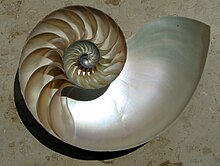Spirala logarytmiczna
Spirala logarytmiczna – krzywa płaska przecinająca pod jednakowym, stałym kątem wszystkie półproste wychodzące z ustalonego punktu, zwanego biegunem spirali.
Opis matematyczny
Wzór opisujący spiralę logarytmiczną we współrzędnych biegunowych, gdy biegun spirali pokrywa się z biegunem (początkiem) układu współrzędnych[1]:
lub
gdzie:
- – podstawa logarytmu naturalnego,
Jeden „koniec” spirali nawija się na biegun (dla spirala asymptotycznie zbliża się do bieguna ), zaś drugi „ucieka” w nieskończoność (dla zwoje spirali rosną nieograniczenie: ).
Stosunek pochodnej wartości promienia względem kąta do promienia jest stały i równy współczynnikowi w wykładniku:
wobec czego kąt pomiędzy spiralą i promieniami (półprostymi) wychodzącymi z bieguna spirali spełnia równość:
Kąt ten jest więc stały:
zaś współczynnik decyduje o tym jak „szybko” oraz w którą stronę spirala się skręca.
Dla kąt – krzywa przecina promienie prostopadle, zatem spirala degeneruje się do okręgu (o równaniu ). Przy dążącym do nieskończoności spirala „rozprostowuje się”, w granicy dążąc do półprostej
Zmiana znaku współczynnika równoważna jest zmianie znaku zmiennej odpowiada zatem symetrii osiowej względem prostej odwzorowując spiralę prawoskrętną w lewoskrętną i odwrotnie.
Współczynnik jest skalą spirali (w funkcji występuje jako mnożnik), odpowiada zatem za wielkość krzywej. Zmiana jego wartości odpowiada obracaniu spirali wokół bieguna – ponieważ
to -krotne zwiększenie współczynnika odpowiada obróceniu spirali o kąt
Równania parametryczne spirali logarytmicznej są więc następujące:
gdzie
Właściwości
- Odległość od środka kolejnych pętel spirali rośnie w postępie geometrycznym.
- Wyruszając z dowolnego punktu spirali i idąc po niej można okrążyć biegun dowolną liczbę razy nie dochodząc do niego. Jednak droga, którą przemierzyć trzeba od tego punktu do bieguna, jest skończona. Tę własność pierwszy zauważył Evangelista Torricelli. Droga ta wynosi:
gdzie to odległość (po linii prostej) punktu od bieguna.
Spirale logarytmiczne w przyrodzie
W wielu zjawiskach i obiektach w przyrodzie można spotkać się z tworami w kształcie spirali logarytmicznej. Przykłady tego są następujące:
- Droga, jaką owad leci do źródła światła. Owady zwykły zachowywać stały kąt pomiędzy torem lotu a źródłem światła. Zazwyczaj Księżyc lub Słońce jest jedynym źródłem światła i lecąc według tej reguły, owady poruszają się po linii prostej.
- Ramiona galaktyki spiralnej. Uważa się, że Droga Mleczna ma 4 główne ramiona, z których każde jest spiralą logarytmiczną o kącie 12°. Ramiona galaktyk spiralnych mają kąty od 10° do 40°.
- Ramiona tropikalnych cyklonów jak huragany.
- Wiele biologicznych struktur jak muszle mięczaków. W tym przypadku spiralny kształt jest wynikiem algorytmu: Weź dowolną figurę płaską F0, pomniejsz ją k razy otrzymując F1 i doklej F1 do F0. Następnie pomniejsz F1 k razy otrzymując F2 i doklej F2 do F1 etc. Powtarzanie tego procesu prowadzi do powstania spiralnego kształtu.
Przekrój muszli łodzika, którego komory ułożone są w spiralę logarytmiczną
Obszar niskiego ciśnienia nad Islandią ze wzorem w kształcie spirali logarytmicznej
Ramiona galaktyk spiralnych często maja kształt spirali logarytmicznej – tu Galaktyka Wir
Zobacz też
Przypisy
- ↑ spirala logarytmiczna, [w:] Encyklopedia PWN [online] [dostęp 2021-12-16].
Linki zewnętrzne
- SpiralZoom.com (ang.) – Angielska strona poświęcona spiralom.
Media użyte na tej stronie
Autor: NASA, ESA, S. Beckwith (STScI), and The Hubble Heritage Team STScI/AURA), Licencja: CC BY 3.0
The Whirlpool Galaxy (Spiral Galaxy M51, NGC 5194) is a classic spiral galaxy located in the Canes Venatici constellation.
Out of this whirl: The Whirlpool Galaxy (M51) and companion galaxy
The graceful, winding arms of the majestic spiral galaxy M51 (NGC 5194) appear like a grand spiral staircase sweeping through space. They are actually long lanes of stars and gas laced with dust.
This sharpest-ever image, taken in January 2005 with the Advanced Camera for Surveys aboard the NASA/ESA Hubble Space Telescope, illustrates a spiral galaxy's grand design, from its curving spiral arms, where young stars reside, to its yellowish central core, a home of older stars. The galaxy is nicknamed the Whirlpool because of its swirling structure.
The Whirlpool's most striking feature is its two curving arms, a hallmark of so-called grand-design spiral galaxies. Many spiral galaxies possess numerous, loosely shaped arms that make their spiral structure less pronounced. These arms serve an important purpose in spiral galaxies. They are star-formation factories, compressing hydrogen gas and creating clusters of new stars. In the Whirlpool, the assembly line begins with the dark clouds of gas on the inner edge, then moves to bright pink star-forming regions, and ends with the brilliant blue star clusters along the outer edge.
Some astronomers believe that the Whirlpool's arms are so prominent because of the effects of a close encounter with NGC 5195, the small, yellowish galaxy at the outermost tip of one of the Whirlpool's arms. At first glance, the compact galaxy appears to be tugging on the arm. Hubble's clear view, however, shows that NGC 5195 is passing behind the Whirlpool. The small galaxy has been gliding past the Whirlpool for hundreds of millions of years.
As NGC 5195 drifts by, its gravitational muscle pumps up waves within the Whirlpool's pancake-shaped disk. The waves are like ripples in a pond generated when a rock is thrown in the water. When the waves pass through orbiting gas clouds within the disk, they squeeze the gaseous material along each arm's inner edge. The dark dusty material looks like gathering storm clouds. These dense clouds collapse, creating a wake of star birth, as seen in the bright pink star-forming regions. The largest stars eventually sweep away the dusty cocoons with a torrent of radiation, hurricane-like stellar winds, and shock waves from supernova blasts. Bright blue star clusters emerge from the mayhem, illuminating the Whirlpool's arms like city streetlights.
The Whirlpool is one of astronomy's galactic darlings. Located 31 million light-years away in the constellation Canes Venatici (the Hunting Dogs), the Whirlpool's beautiful face-on view and closeness to Earth allow astronomers to study a classic spiral galaxy's structure and star-forming processes.
Credit:
NASA, ESA, S. Beckwith (STScI), and The Hubble Heritage Team STScI/AURA)
About the Image
NASA caption Id: heic0506a Type: Observation Release date: 25 April 2005, 06:00 Related releases: heic0506 Size: 11477 x 7965 px
About the Object
Name: Messier 51, Whirlpool Galaxy Type: • Local Universe : Galaxy : Type : Spiral • Galaxies Images/Videos Distance: 25 million light years
Colours & filters
Band Wavelength Telescope Optical B 435 nm Hubble Space Telescope ACS Optical V 555 nm Hubble Space Telescope ACS Optical H-alpha + Nii 658 nm Hubble Space Telescope ACS Infrared I 814 nm Hubble Space Telescope ACS.
A beautifully-formed low-pressure system swirls off the southwestern coast of Iceland, illustrating the maxim that "nature abhors a vacuum." The vacuum in this case would be a region of low atmospheric pressure. In order to fill this void, air from a nearby high-pressure system moves in, in this case bringing clouds along for the ride. And because this low-pressure system occurred in the Northern Hemisphere, the winds spun in toward the center of the low-pressure system in a counter-clockwise direction; a phenomenon known as the Coriolis force (in the Southern Hemisphere, the Coriolis force would be manifested in a clockwise direction of movement). The clouds in the image resembled pulled cotton and lace as they spun in a lazy hurricane-like pattern. This huge system swirled over the Denmark Strait in between Greenland and Iceland. The image was taken by the Aqua MODIS instrument on September 4, 2003.
Autor: user:Pbroks13 on en wikipedia, Licencja: CC-BY-SA-3.0
Made with matplotlib:
#!/usr/bin/env python
from pylab import *
rc('grid', color='#aaaaaa', linewidth = 1, linestyle = '-')
rc('xtick', labelsize=0)
figure(figsize = (20, 20))
ax = axes([0.1, 0.1, 0.8, 0.8], polar = True)
t = arange(-4 * pi, 4 * pi, .01)
polar(t, 1.19**t, linewidth = 2)
savefig('logarithmic_spiral.svg')
Logarithmic spiral.









